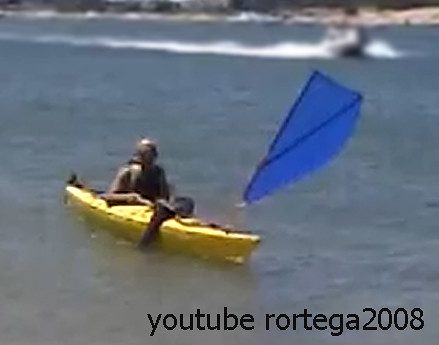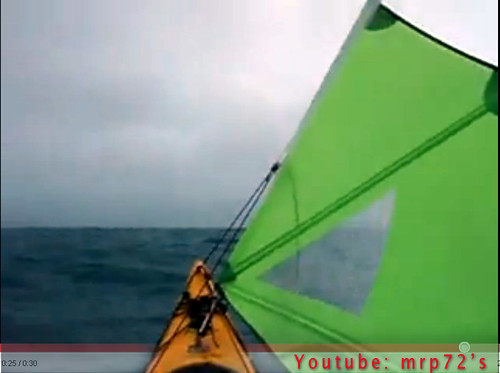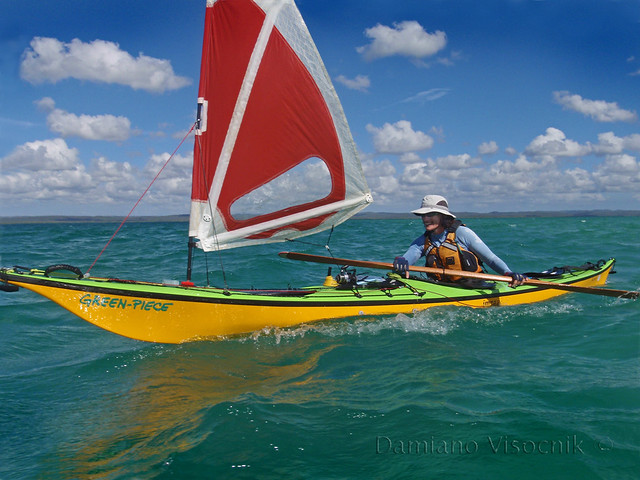I never liked the twin mast one and even less the step mast ones where the sail would interfere with my paddling stroke.
I believe that a collapsible mast is a safe sail too, taking only a split second to depower when the wind suddenly becomes just too strong to sail.
I currently use Flat Earth Sails and while they are more efficient than similar style sails (lateen) they require thoughtful mounting.
I have seen and read about sails that have failed when the breeze picked up above 15 knots; surprisingly those failures could have been avoided if the sailor would have set them up correctly.
A single mast sail should be kept as vertical as possible when sailing since tilting the kayak away from the breeze usually spills the wind and slows the boat down.
While often unavoidable, a paddler should counteract the heeling of the kayak to maintain proper balance and forward momentum.
When I set up a sail on my kayaks I take a fair amount of time to create the perfect-length stays. I secure high quality line (always Dyneema) to a very solid anchor on deck.
My anchors are spaced widely apart on the edge of the kayak's deck. Using existing deck fitting for anchors only works if they are in the right spot.Early experimentation demonstrated that stays too close to the base will not keep the mast upright.
Proper length stays are a critical component to successful sailing.
As unsolicited advice can be met with contempt, I often refrain from commenting (on the spot) when I see a set up destined to fail.
I have witnessed stays attached to the kayak's perimeter lines because the owner didn't want/care to create proper anchors for the stays.
When perimeter lines do stretch under the strain of the wind the mast would then often collapse.

not so good set up
Needless to say the paddler would then blame the sail manufacturer and tout that his sails are rubbish.
So how do you set up the sail to keep up in strong winds?
I mentioned Dyneema line, in my opinion the crucial part. Nylon stretches when wet and elongates under load.
Secondly I make sure that the stays are just a bit on the short side. When the wind loads the sail the polymer mast joiner (base) deforms a bit and compresses. A stay that is a bit too long would then angle the mast precariously.

sail about to collapse
Lastly I make sure that the deck of my kayaks don't flex under the base of the mast.
Most kayaks' decks are not designed to take a concentrated load in one spot. Peaked decks are better but often still not strong enough.
Since I don't like creating metal plates externally under the mast's base, I prefer to reinforce the deck of the kayak internally. A few layers of quality fibreglass cloth (even carbon, if I have any scraps laying around) make a much neater set up than agricultural looking metal plates, in my opinion, and lighter.

sail set up with mast in upright position
I use quality cleats that keep the uphaul line in position. I hate nylon cleats that let the rope slip.
A tensioned uphaul will keep the mast upright.
And finally the fasteners that keep the stays attached to the deck anchors.
I don't use snap links and even less clasps.
Nothing is more solid, secure and unobtrusive than a proper small "D" shackle.
It might take a second longer to secure it but I am positively sure it won't let go.
So, if your sail set up has failed you consider checking the above pointers.
If any other cause is not keeping your sail upright I might be able to advise you on a solution.
JUL 2012: updates on sail set up here
.

Dear guru of all things kayaking, I (the reader) feel blessed by your continual willingness to share your knowledge and experience, your kayaking abilities are indeed something to be envied. It is implausible that others with some experience in the sport will ever reach the pinnacle of your skill and ability, or demonstrate such an extensive history and mastery of kayak fitting that rivals your own accomplishments. I wish you all the best in your future kayaking endeavors in the hope that your unbiased opinions will continue to soar on the internet above all the rest, yours sincerely, the reader
ReplyDeleteDear Anonymous,
ReplyDeleteI feel totally chaffed by your comments and you just made me gloat.
You are most welcome and I am glad to be of service.
Though I somehow feel that you have gone just a notch beyond the praise and forgive me if a sense just a smidgen of sarcasm or is that jealousy?
Maybe revealing your identity would give your comment more credibility.
“Jealousy - that jumble of secret worship and ostensible aversion.
Emile M. Cioran”
Don’t be hating just coz you live in that sunny place called Sydney.
Hello, I am the author of the youtube video from which you got the picture of the yellow kayak rortega2008 (Necky Zoar Sport) with blue sail.
ReplyDeleteThe sail was a prototype I was testing the first time. Like any prototype, it had some problems, as I commented in my blog where I published the video (http://perdioenalmonte.blogspot.com/2011/06/una-vela-para-el-kayak.html ).
As you say, the mast was still not held vertically and even sometimes fell into the water. But the problem was not in the stays, they were similarly configured as you explined in your blog, from which I got the idea.
The real problem was the base of the mast. I followed the system that you indicated in option C) in your blog post to attach the mast to the kayak (http://gnarlydognews.blogspot.com/search/label/sail), which did not work in my sail and was the cause of all verticality problems. I could not use option A) or B) because it was in my area Rostan RF1127 piece or tiller extension.
I decided to make my own base of the mast and since I installed the wing behaves perfectly with winds over 15 knots. You can see the manufacturing process of the mast in http://perdioenalmonte.blogspot.com/2011/07/vela-casera-para-el-kayak-iv-la-base.html
After mounting the mast on the kayak, I made a new test and the result was very satisfactory. You can see a video of that test in http://www.youtube.com/watch?v=eBHhZ_ygQ2A). Also check the result in the post http://perdioenalmonte.blogspot.com/2011/07/navegando-vela-por-la-ria-de-huelva.html. It is the blue sail, which used my Wife in that moment (the white sail is another prototype which I discarded).
Some weeks ago I made a second sail (also blue) in which I fixed other problems in the first design. Due to time constraints I have not yet uploaded images, videos and explanations to my blog, I'm working on it and publish a post soon.
It souns good that you've explained these problems citing the image of my sail with the initial problems, but I would be grateful if you complete your post with the information I have provided indicating that the problems of my design were corrected before you publish this post.
I would like to add that I am very grateful to you because I got some great ideas from your blog to make my own sail, and I included in one of my posts a link to your website.
Thank you.
Raul, thank you for your addition to the sail set up. You prove that it takes a bit of time to set up a sail correctly, especially when you have to fabricate your own parts.
ReplyDeleteThe various links that you mention are in Spanish and can be translated with Google
Translate: http://translate.google.com/#es|en|
Yes, I'm spanish.
ReplyDeleteHi Gnarls-
ReplyDeleteDoesn't look like you could roll the kayak with the mast up. Also that it might be a bitch to right if you bailed out and the kayak was inverted 180. Not something I would try on my Nordkapp, where a low COG is my friend...
What's your take on this?
Moulton
Moulton, there are two options there.
ReplyDeleteIf the wind is mild one can roll with the sail deployed but should reef it out (let it loose) as seen in this post: http://gnarlydognews.blogspot.com/2010/01/sail-roll.html
If the wind is hooting (that’s when one is more likely to capsize) then it’s best to collapse the sail and roll back up with the mast down. I don’t have the presence of mind of letting go of the uphaul (rope that keeps the mast vertical) while underwater.
I end up wet exiting, collapse the mast and then re-enter and roll.
Surprisingly I had to do that only a couple of times; the kayak seems rather stable when sailing…